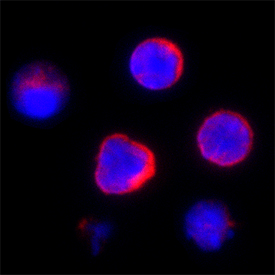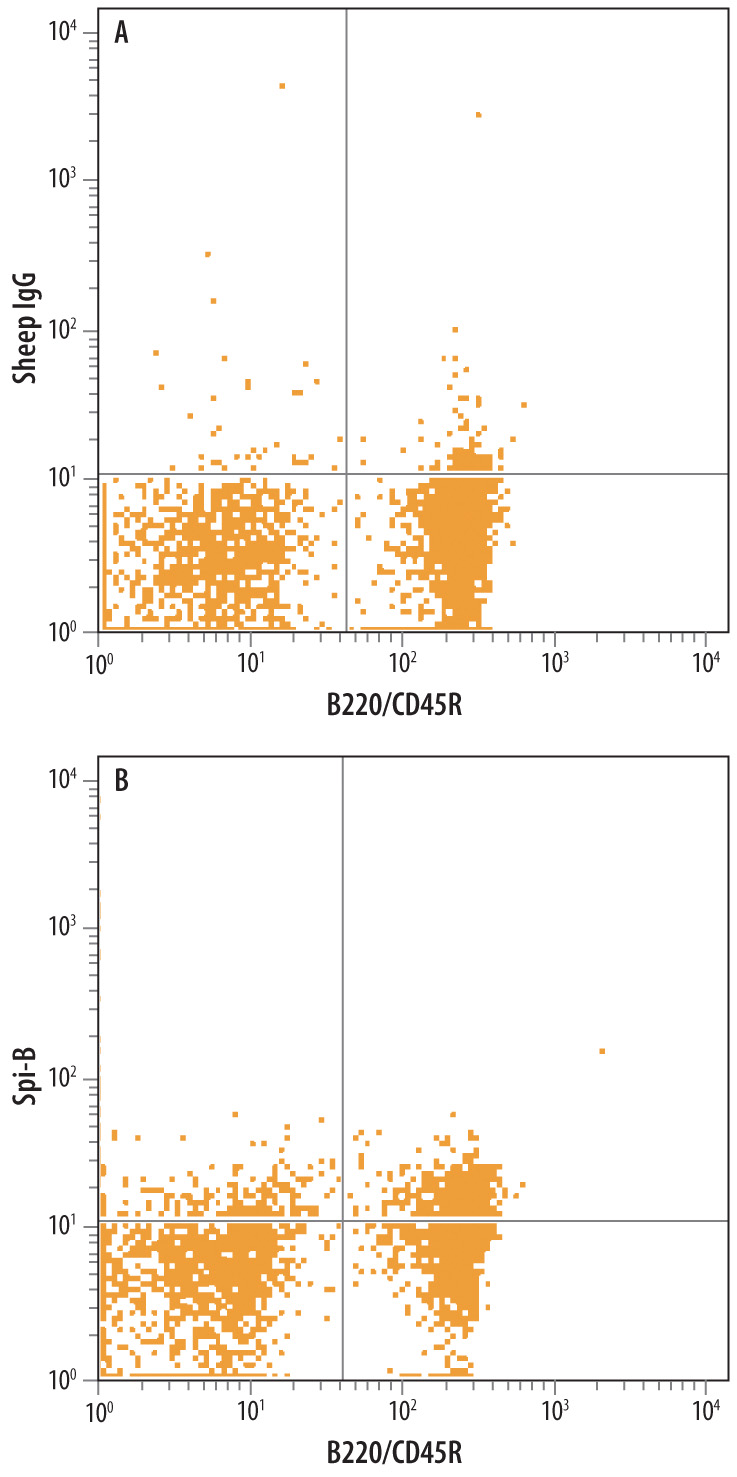Mouse Spi-B Antibody Summary
Tyr18-Glu167 (Tyr110Phe)
Accession # O35906
Applications
Please Note: Optimal dilutions should be determined by each laboratory for each application. General Protocols are available in the Technical Information section on our website.
Scientific Data
 View Larger
View Larger
Spi-B in Mouse Splenocytes. Spi-B was detected in immersion fixed mouse splenocytes using Sheep Anti-Mouse Spi-B Antigen Affinity-purified Polyclonal Antibody (Catalog # AF7204) at 15 µg/mL for 3 hours at room temperature. Cells were stained using the NorthernLights™ 557-conjugated Anti-Sheep IgG Secondary Antibody (red; Catalog # NL010) and counterstained with DAPI (blue). Specific staining was localized to plasma membranes and cytoplasm. View our protocol for Fluorescent ICC Staining of Non-adherent Cells.
 View Larger
View Larger
Detection of SPi-B in Mouse Splenocytes by Flow Cytometry. Mouse splenocytes were stained with Sheep Anti-Mouse Spi-B Antigen Affinity-purified Polyclonal Antibody (Catalog # AF7204) followed by Allophycocyanin-conjugated Anti-Sheep IgG Secondary Antibody (Catalog # F0127) and Rat Anti-Mouse B220/CD45R PE-conjugated Monoclonal Antibody (Catalog # FAB1217P). Quadrant markers were set based on control antibody staining (Catalog # 5-001-A). To facilitate intracellular staining, cells were fixed with paraformadehyde and permeabilized with saponin.
Reconstitution Calculator
Preparation and Storage
- 12 months from date of receipt, -20 to -70 °C as supplied.
- 1 month, 2 to 8 °C under sterile conditions after reconstitution.
- 6 months, -20 to -70 °C under sterile conditions after reconstitution.
Background: Spi-B
Spi-B (Transcription factor Spi-B) is a 33-45 kDa member of the ets family of transcription factors. It is found in hematopoietic cells such as B cells and plasmacytoid dendritic cells (DC). In transitional B cells, Spi-B promotes their differentiation into follicular (naïve) B cells. In hematopoietic stem cells, Spi-B stimulates the generation of IFN-producing plasmacytoid DC at the expense of T, B and NK cell development. Mouse Spi-B is 267 amino acids (aa) in length. It contains a dual transactivation region (aa 1-62), plus a PEST domain (aa 110-170) and an Ets DNA-binding domain (aa 174-257). There are two isoform variants. One shows a nine aa substitution for aa 1-8, while a second possesses an 18 aa insertion after Leu17. Over aa 18-167, mouse Spi-B shares 91% and 74% aa identity with rat and human Spi-B, respectively.
Product Datasheets
Citations for Mouse Spi-B Antibody
R&D Systems personnel manually curate a database that contains references using R&D Systems products. The data collected includes not only links to publications in PubMed, but also provides information about sample types, species, and experimental conditions.
7
Citations: Showing 1 - 7
Filter your results:
Filter by:
-
ONECUT2 regulates RANKL-dependent enterocyte and microfold cell differentiation in the small intestine; a multi-omics study
Authors: MV Luna Velez, HK Neikes, RR Snabel, Y Quint, C Qian, A Martens, GJC Veenstra, MR Freeman, SJ van Heerin, M Vermeulen
Nucleic Acids Research, 2023-02-22;0(0):.
Species: Mouse
Sample Types: Whole Tissue
Applications: IHC -
The gut microbiota induces Peyer's-patch-dependent secretion of maternal IgA into milk
Authors: K Usami, K Niimi, A Matsuo, Y Suyama, Y Sakai, S Sato, K Fujihashi, H Kiyono, S Uchino, M Furukawa, J Islam, K Ito, T Moriya, Y Kusumoto, M Tomura, RC Hovey, J Sugawara, H Yoneyama, H Kitazawa, K Watanabe, H Aso, T Nochi
Cell Reports, 2021-09-07;36(10):109655.
Species: Transgenic Mouse
Sample Types: Whole Tissue
Applications: IHC -
Osteoprotegerin-dependent M cell self-regulation balances gut infection and immunity
Authors: S Kimura, Y Nakamura, N Kobayashi, K Shiroguchi, E Kawakami, M Mutoh, H Takahashi-, T Yamada, M Hisamoto, M Nakamura, N Udagawa, S Sato, T Kaisho, T Iwanaga, K Hase
Nat Commun, 2020-01-13;11(1):234.
Species: Mouse
Sample Types: Whole Cells
Applications: ICC/IF -
The role of CSF1R-dependent macrophages in control of the intestinal stem-cell niche
Authors: A Sehgal, DS Donaldson, C Pridans, KA Sauter, DA Hume, NA Mabbott
Nat Commun, 2018-03-28;9(1):1272.
Species: Mouse
Sample Types: Whole Tissue
Applications: IHC -
Development of intestinal M cells and follicle-associated epithelium is regulated by TRAF6-mediated NF-?B signaling
Authors: T Kanaya, S Sakakibara, T Jinnohara, M Hachisuka, N Tachibana, S Hidano, T Kobayashi, S Kimura, T Iwanaga, T Nakagawa, T Katsuno, N Kato, T Akiyama, T Sato, IR Williams, H Ohno
J. Exp. Med., 2018-01-16;0(0):.
Species: Mouse
Sample Types: Whole Tissue
Applications: IHC-P -
Increased Abundance of M Cells in the Gut Epithelium Dramatically Enhances Oral Prion Disease Susceptibility
PLoS Pathog, 2016-12-14;12(12):e1006075.
Species: Mouse
Sample Types: Whole Tissue
Applications: IHC-Fr -
c-Rel is dispensable for the differentiation and functional maturation of M cells in the follicle-associated epithelium
Immunobiology, 2016-09-18;0(0):.
Species: Mouse
Sample Types: Whole Tissue
Applications: IHC
FAQs
No product specific FAQs exist for this product, however you may
View all Antibody FAQsReviews for Mouse Spi-B Antibody
There are currently no reviews for this product. Be the first to review Mouse Spi-B Antibody and earn rewards!
Have you used Mouse Spi-B Antibody?
Submit a review and receive an Amazon gift card.
$25/€18/£15/$25CAN/¥75 Yuan/¥2500 Yen for a review with an image
$10/€7/£6/$10 CAD/¥70 Yuan/¥1110 Yen for a review without an image


